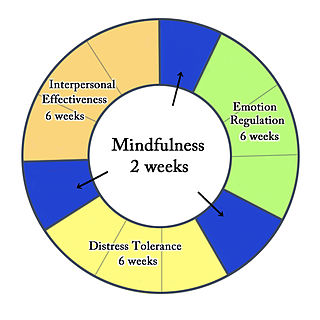Related Research Articles

Post-traumatic stress disorder (PTSD) is a mental and behavioral disorder that can develop because of exposure to a traumatic event, such as sexual assault, warfare, traffic collisions, child abuse, domestic violence or other threats on a person's life. Symptoms may include disturbing thoughts, feelings, or dreams related to the events, mental or physical distress to trauma-related cues, attempts to avoid trauma-related cues, alterations in the way a person thinks and feels, and an increase in the fight-or-flight response. These symptoms last for more than a month after the event. Young children are less likely to show distress, but instead may express their memories through play. A person with PTSD is at a higher risk of suicide and intentional self-harm.

Dialectical behavior therapy (DBT) is an evidence-based psychotherapy that began with efforts to treat borderline personality disorder. There is evidence that DBT can be useful in treating mood disorders, suicidal ideation, and for change in behavioral patterns such as self-harm and substance use. DBT evolved into a process in which the therapist and client work with acceptance and change-oriented strategies, and ultimately balance and synthesize them, in a manner comparable to the philosophical dialectical process of hypothesis and antithesis, followed by synthesis.
Psychological trauma is damage to a person's mind as a result of one or more events that cause overwhelming amounts of stress that exceed the person's ability to cope or integrate the emotions involved, eventually leading to serious, long-term negative consequences. Trauma is not the same as mental distress.
Eye movement desensitization and reprocessing (EMDR) is a form of psychotherapy developed by Francine Shapiro starting in 1988 in which the person being treated is asked to recall distressing images; the therapist then directs the patient in one type of bilateral stimulation, such as side-to-side eye rapid movement or hand tapping. According to the 2013 World Health Organization (WHO) practice guideline: "This therapy [EMDR] is based on the idea that negative thoughts, feelings and behaviours are the result of unprocessed memories. The treatment involves standardized procedures that include focusing simultaneously on (a) spontaneous associations of traumatic images, thoughts, emotions and bodily sensations and (b) bilateral stimulation that is most commonly in the form of repeated eye movements."
Somatic experiencing is a form of alternative therapy aimed at treating trauma and stressor related disorders like PTSD. The primary goal of SE is to modify the trauma-related stress response. To achieve this, its major interventional strategy builds on bottom-up processing. Clients’ attention is directed to internal sensations,, rather than to primarily cognitive or emotional experiences. It was developed by trauma therapist Peter A. Levine.
Complex post-traumatic stress disorder is a psychological disorder that can develop in response to prolonged, repeated experience of interpersonal trauma in a context in which the individual has little or no chance of escape. C-PTSD relates to the trauma model of mental disorders and is associated with chronic sexual, psychological, and physical abuse or neglect, or chronic intimate partner violence, victims of kidnapping and hostage situations, indentured servants, victims of slavery and human trafficking, sweatshop workers, prisoners of war, concentration camp survivors, residential school survivors, prisoners kept in solitary confinement for a long period of time, and defectors from authoritarian religions. It is most often directed at children and emotionally vulnerable adults, and whilst motivations behind such abuse vary, though mostly being predominantly malicious, it has also been shown that the motivations behind such abuse can be well-intentioned. Situations involving captivity/entrapment can lead to C-PTSD-like symptoms, which can include prolonged feelings of terror, worthlessness, helplessness, and deformation of one's identity and sense of self.
Frank Ochberg, is a psychiatrist, a pioneer in trauma science, an educator and the editor of the first text on the treatment of post-traumatic stress disorder (PTSD). He is one of the founding fathers of modern psychotraumatology and served on the committee that defined PTSD. He is a graduate of Harvard and of Johns Hopkins Medical School.

Animal-assisted therapy is an alternative or complementary type of therapy that includes the use of animals in a treatment. It falls under the realm of Animal Assisted Intervention, which encompasses any intervention in the studio that includes an animal in a therapeutic context such as emotional support animals, service animals trained to assist with daily activities, and animal assisted activity. Animal-assisted therapy can be classified by the type of animal, the targeted population, and how the animal is incorporated into the therapeutic plan. The most commonly used types of animal-assisted therapy are canine-assisted therapy and equine-assisted therapy. The goal of animal-assisted therapy is to improve a patient's social, emotional, or cognitive functioning and literature reviews state that animals can be useful for educational and motivational effectiveness for participants. Studies have documented some positive effects of the therapy on subjective self-rating scales and on objective physiological measures such as blood pressure and hormone levels.
Exposure therapy is a technique in behavior therapy to treat anxiety disorders. Exposure therapy involves exposing the target patient to the anxiety source or its context without the intention to cause any danger. Doing so is thought to help them overcome their anxiety or distress. Procedurally, it is similar to the fear extinction paradigm developed studying laboratory rodents. Numerous studies have demonstrated its effectiveness in the treatment of disorders such as generalized anxiety disorder, social anxiety disorder, obsessive-compulsive disorder, post-traumatic stress disorder (PTSD), and specific phobias.
Prolonged exposure therapy (PE) is a form of behavior therapy and cognitive behavioral therapy designed to treat post-traumatic stress disorder. It is characterized by two main treatment procedures – imaginal and in vivo exposures. Imaginal exposure is repeated 'on-purpose' retelling of the trauma memory. In vivo exposure is gradually confronting situations, places, and things that are reminders of the trauma or feel dangerous. Additional procedures include processing of the trauma memory and breathing retraining.

International Society for Traumatic Stress Studies is a professional network established on March 2, 1985, in Washington, D.C. It is dedicated to disseminating the state of the science as it pertains to our understanding about the effects of trauma exposure, traumatic stress, evidence-based assessment of trauma and associated symptoms, and evidence-based prevention and treatment intervention approaches. The society provides a forum for sharing research, clinical strategies, public policy issues and theoretical formulations on trauma around the world. Members include psychiatrists, psychologists, social workers, nurses, counselors, researchers, administrators, advocates, journalists, clergy, and other professionals with an interest in the study and treatment of traumatic stress. Members come from a variety of clinical and non-clinical settings around the world, including public and private health facilities, private practice, universities, non-university research foundations, and many different cultural backgrounds.
Cognitive processing therapy (CPT) is a manualized therapy used by clinicians to help people recover from posttraumatic stress disorder (PTSD) and related conditions. It includes elements of cognitive behavioral therapy (CBT) treatments.The Cognitive Behaviour Therapy procedure is one of the most widely used and common talk therapies and was the first form of talk therapy tested with strict criteria.A typical 12-session run of CPT has proven effective in treating PTSD across a variety of populations, including combat veterans, sexual assault victims, and refugees. CPT can be provided in individual and group treatment formats.
Bessel van der Kolk is a psychiatrist, author, researcher and educator based in Boston, USA. Since the 1970s his research has been in the area of post-traumatic stress. He is the author of The New York Times best seller, The Body Keeps the Score. Van der Kolk served as a past president for the International Society for Traumatic stress Studies and former co-director of the National Child Traumatic Stress Network. He is a professor of Psychiatry at Boston University School of Medicine and president of the Trauma Research Foundation in Brookline, Massachusetts.
PTSD is a psychiatric disorder characterized by intrusive thoughts and memories, dreams, or flashbacks of the event; avoidance of people, places, and activities that remind the individual of the event; ongoing negative beliefs about oneself or the world, mood changes, and persistent feelings of anger, guilt, or fear; alterations in arousal such as increased irritability, angry outbursts, being hypervigilant, or having difficulty with concentration and sleep. PTSD is commonly treated with various types of psychotherapy and pharmacotherapy.
The Clinically Administered PTSD Scale (CAPS) is an in-person clinical assessment for measuring posttraumatic stress disorder (PTSD). The CAPS includes 30 items administered by a trained clinician to assess PTSD symptoms, including their frequency and severity. The CAPS distinguishes itself from other PTSD assessments in that it can also assess for current or past diagnoses of PTSD.
Progressive counting (PC) is a psychotherapy technique developed by Ricky Greenwald designed for trauma resolution based on the counting method. It is used to reduce or eliminate symptoms such as anxiety, depression, guilt, anger, and post-traumatic reactions. It can also be used to enhance psychological resources such as confidence and self-esteem. The procedure involves having the client visualize a series of progressively longer "movies" of the trauma memory while the therapist counts out loud. By repeatedly imagining the movie of the memory, the memory gets "digested" or healed, via desensitization, emotional processing, gaining perspective, or other means.
Eclectic psychotherapy is a form of psychotherapy in which the clinician uses more than one theoretical approach, or multiple sets of techniques, to help with clients' needs. The use of different therapeutic approaches will be based on the effectiveness in resolving the patient's problems, rather than the theory behind each therapy.
Psychosensory therapy is a form of therapeutic treatment that uses sensory stimuli to affect psychological and emotional health. In addition, psychosensory therapy is a group of therapeutic techniques that involves applying sensory inputs to treat various behaviors, mood, thoughts, symptoms, and pain. Psychosensory therapy has its roots in traditional Chinese medicine in addition to energy psychology. Some important figures in psychosensory therapy include chiropractor George Goodheart, psychiatrist John Diamond, clinical psychologist Roger Callahan, and Ronald Ruden.
Trauma survivors are a distinctive population with varying displays of resilience, posttraumatic growth, and resulting mental disorders. Mental health professionals who treat trauma survivors must incorporate specific ethical considerations when working with clients who have a history of trauma.

The nature of a first responder's occupation continuously puts them in harm's way as well as regularly expose them to others who have been injured or harmed. First responders are normally the first people on the scene and experience difficult situations. They are the first to help survivors and give emotional assistance to people caught in a trauma situation. The responsibilities that first responders have are very important but over time have put their well being and overall health at risk. Trauma is the emotional shock that follows a very stressful event or a physical injury. These occupations subject individuals to a great deal of traumatic events, resulting in a higher risk of developing post-traumatic stress disorder (PTSD), major depressive disorder (MDD), panic disorder (PD), and generalized anxiety disorder (GAD). Exposure to multiple traumatic stressors could also exacerbate other pre-existing conditions. The presence of any mental health disorders in these individuals can also be associated with diminished ability to work efficiently, early retirement, substance abuse, and suicide. The term First responders was written in The U.S. Homeland Security Presidential Directive, HSPD-8, defines "The term "first responder" refers to those individuals who in the early stages of an incident are responsible for the protection and preservation of life, property evidence, and the environment, including emergency response providers" The term first responder can refer to Law enforcement, Firefighters, EMT's, Paramedics, Dispatchers, and soldiers.
References
- 1 2 "The Counting Method: Brief Treatment for PTSD". www.countingmethod.com.
- ↑ "Gift From Within - Article: "The Counting Method for Ameliorating Traumatic Memories"". www.giftfromwithin.org.
- ↑ ""The Counting Method as Exposure Therapy: Revisions and Case Examples". David Read Johnson and Hadar Lubin. Traumatology, Vol.11 No.3 September 2005. 190–191" (PDF).